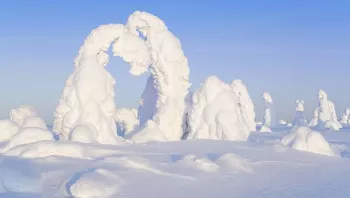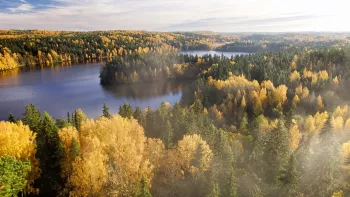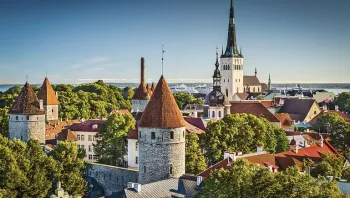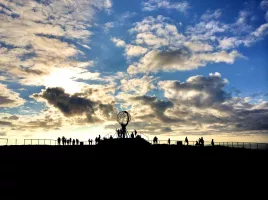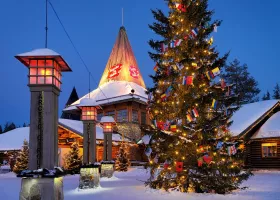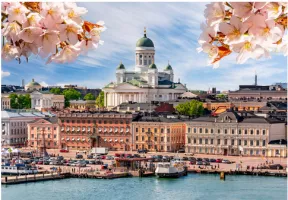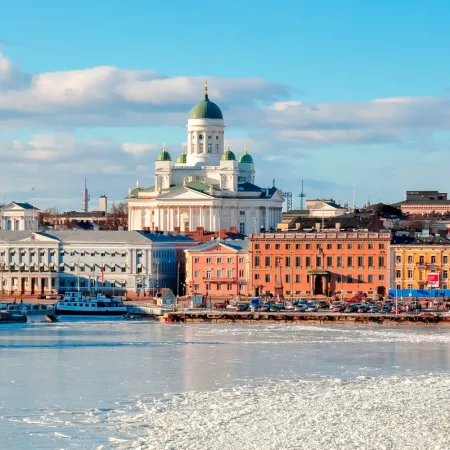
Finland
Duration
5 to 10 Days
5 to 10 Days
Best time to visit
Jun-Aug
Jun-Aug
Theme
Hill Station, Adventure, Wildlife, Waterfront
Hill Station, Adventure, Wildlife, Waterfront
Finland Travel Guide
Located in Northern Europe, **Finland** is a country known for its stunning natural landscapes, including thousands of lakes, dense forests, and the magical Northern Lights. With a rich history dating back to the Vikings and unique cultural traditions like sauna bathing and reindeer herding, Finland offers a one-of-a-kind travel experience. The country is famous for its modern design, high-quality education system, and being the happiest country in the world.
Top Attractions in Finland
- Visit the historic Suomenlinna Fortress in Helsinki
- Experience the Arctic wilderness in Lapland
- Explore the vibrant market squares in Turku
- Discover the stunning natural beauty of the Åland Islands
- Witness the Midnight Sun during the summer months
Finland is Famous for
Its breathtaking Northern Lights display.
Top Attractions in Finland
- Chasing the Northern Lights in Lapland
- Meeting Santa Claus at Rovaniemi's Santa Claus Village
- Exploring the UNESCO-listed Old Rauma
- Cruising through the picturesque Finnish Lakeland
- Hiking in the stunning Oulanka National Park
What's Great about Travelling to Finland?
- Perfect destination for nature lovers and outdoor enthusiasts
- Safe and peaceful environment for solo travelers and families
- Unique cultural experiences like sauna rituals and ice swimming
What's Not So Great about Travelling to Finland?
- Expensive compared to other European countries
- Cold weather can be challenging for some travelers
- Limited daylight hours during the winter months
Travel Tips for Finland
- Ensure to pack warm clothing and layers for all seasons
- Public transportation is efficient, but renting a car offers more flexibility
- Respect the local customs and traditions, especially in saunas
Important Finland trip information
- Ideal Duration: 7-10 days to explore the main highlights
- Best Time to Visit: Summer for outdoor activities, winter for Northern Lights
- Nearby Airports and Railway Stations: Helsinki-Vantaa Airport, Rovaniemi Railway Station
Per Person
899
*EXCLUDING APPLICABLE TAXES 5.0 Ratings
( 8334 Reviews )
( 8334 Reviews )
Per Person
899
*EXCLUDING APPLICABLE TAXES 5.0 Ratings
( 8334 Reviews )
( 8334 Reviews )
Per Person
1,899
*EXCLUDING APPLICABLE TAXES 5.0 Ratings
( 8334 Reviews )
( 8334 Reviews )
Per Person
1,699
*EXCLUDING APPLICABLE TAXES 5.0 Ratings
( 8334 Reviews )
( 8334 Reviews )
Per Person
1,999
*EXCLUDING APPLICABLE TAXES 5.0 Ratings
( 8334 Reviews )
( 8334 Reviews )
Per Person
1,399
*EXCLUDING APPLICABLE TAXES 5.0 Ratings
( 8334 Reviews )
( 8334 Reviews )
FAQ's on Finland
Q1: What is the best time to visit Finland?
The best time to visit Finland is during the summer months from June to August when the weather is mild, and the country experiences the midnight sun. Winter is also popular for activities like skiing and seeing the Northern Lights. However, it can be very cold. Consider visiting in September or May for fewer crowds and pleasant weather.
Q2: Do I need a visa to travel to Finland?
Most tourists from EU countries do not need a visa to enter Finland. Travelers from many other countries, including the US and Canada, can visit for up to 90 days without a visa. Check the official government website for the most up-to-date visa requirements and any exceptions.
Q3: What are the must-visit attractions in Finland?
Some of the top attractions in Finland include the Northern Lights, Santa Claus Village in Rovaniemi, the stunning archipelago of Turku, the vibrant capital city of Helsinki, and the UNESCO-listed Suomenlinna Sea Fortress. Nature lovers will enjoy the Finnish Lakeland region and the national parks like Nuuksio and Lemmenjoki.
Q4: Is Finland a safe place to travel?
Finland is considered one of the safest countries in the world with low crime rates. However, like any destination, tourists should still be cautious of pickpocketing in crowded areas and follow general safety precautions. Avoid leaving valuables unattended and be aware of your surroundings, especially in tourist areas.
Q5: What is the local currency in Finland and can I use credit cards?
The local currency in Finland is the Euro (€). Credit cards are widely accepted in hotels, restaurants, and shops. ATMs are also readily available in cities and towns. It's advisable to carry some cash when visiting remote areas or small villages.
Q6: What is the local cuisine like in Finland?
Finnish cuisine is known for its fresh and simple flavors, with a focus on local ingredients like fish, berries, and mushrooms. Must-try dishes include traditional salmon soup, reindeer meat, Karelian pasties, and rye bread. For dessert, try the famous cinnamon buns or blueberry pie. Vegetarian and vegan options are also becoming more widely available.
Q7: What transportation options are available in Finland?
Finland has an efficient transportation system with options including trains, buses, trams, and taxis in cities. Renting a car is a great way to explore the countryside and remote areas. Domestic flights are also available for longer distances. In winter, consider using snowmobiles or husky sleds for a unique experience.
Q8: Are there any cultural norms or etiquette I should be aware of when visiting Finland?
In Finland, punctuality is highly valued, so always be on time for appointments. Finns appreciate personal space and privacy, so avoid intrusive questions or invading someone's personal bubble. Removing shoes before entering someone's home is a common practice. Saunas are an integral part of Finnish culture, so don't be surprised if invited to one. Lastly, remember to greet people with a firm handshake and maintain eye contact during conversations.
Q9: I am a travel agent. How can I buy travel leads of Finland?
Register yourself as a travel agent at agents.tripclap.com and then you can buy travel leads to Finland once your account is approved. For more details contact our support team at +91-8069186564 or support@tripclap.com
